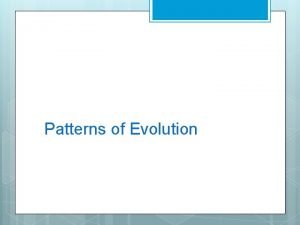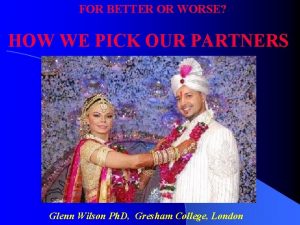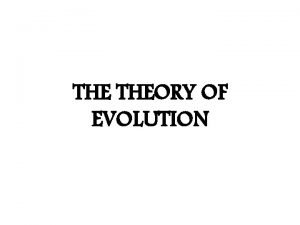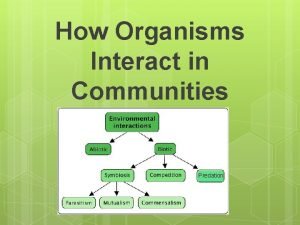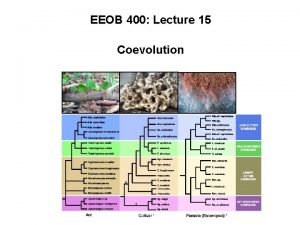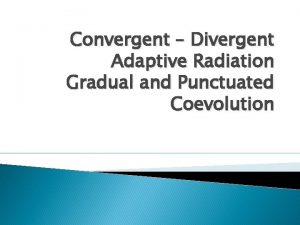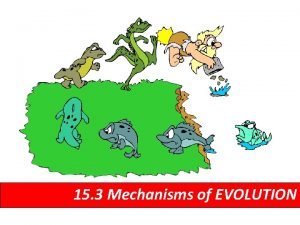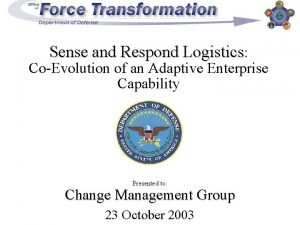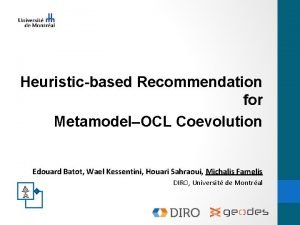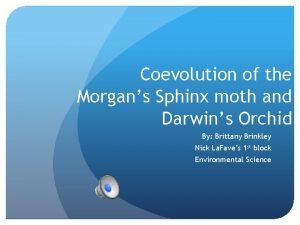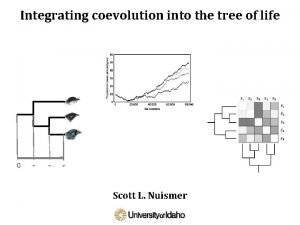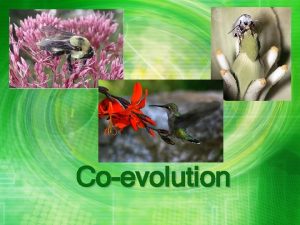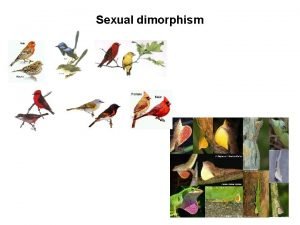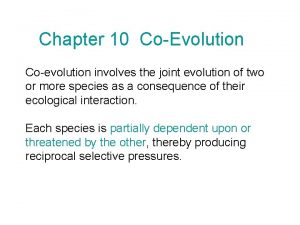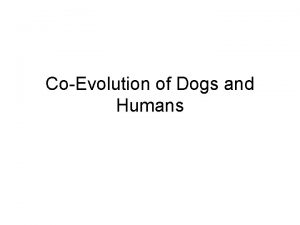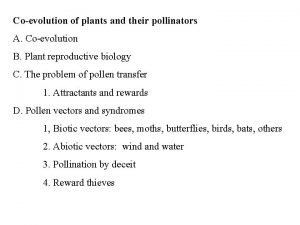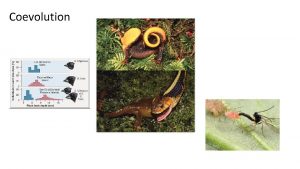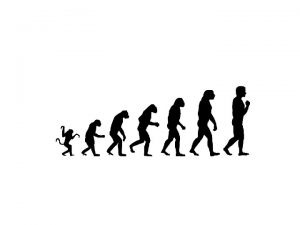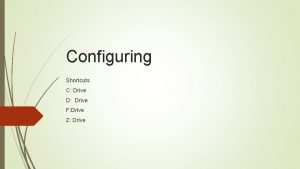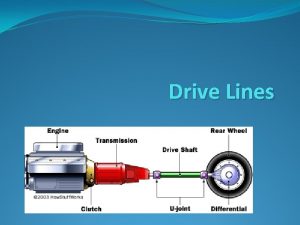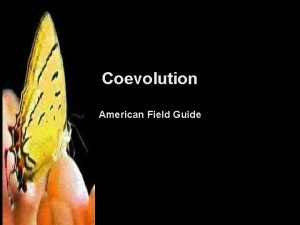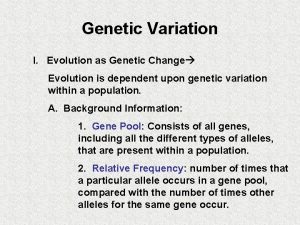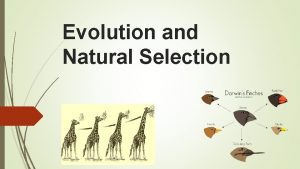Processes that Drive Evolution Coevolution Sexual selection Genetic






























- Slides: 30

Processes that Drive Evolution Coevolution Sexual selection Genetic drift

Coevolution: Evolutionary arms race between species • Predator prey relationships are an excellent example Leopard and Antelope Bat and Moth

http: //intro. bio. rpi. edu/Studio/1 Evolution/5

http: //intro. bio. rpi. edu/Stud You. Tube copy

Coevolution is: A. a special type of evolution that differs from Darwinian evolution. B. a type of evolutionary change that occurs between a population and the physical environment in which that population lives. C. the evolution of individuals within a population in response to selection pressure from other individuals in the population. D. the evolution of two populations of different species in response to selection pressures that individuals from the two populations place on each other.

Sexual Selection Why such big antlers? Why such fancy tails? Why such a colorful nose?

Video: Sexual Selection

Video: Sexual Selection youtube copy

Questions: • If there are costs associated with these exaggerated traits, why did they evolve? • Why do females choose males with exaggerated traits?

The Peacock’s Tail

Ornaments Signal Good Alleles

Ornaments Signal Good Alleles

Females Select Indicators of Good Genes In stalk-eyed flies, females have more offspring when they choose mates with long eye stalks. In tragopans, brightness and symmetry of display are honest indicators of male health.

Video: Seahorse Reproduction

Video: Male Seahorse Gives Birth

Video: Seahorse Reproduction you. Tube copy Video: Male Seahorse Gives Birth Local copy

Seahorse Mating Behavior Based on the video, which sex would you predict to be choosier when it comes to mating? A. Male B. Female C. Both D. Neither

The sex lives of voles Male Montane Vole Polygamous Male Prairie Vole Monogamous Never settles down with one partner, lives more in isolation, gets around Choose female, mate 24 hours, remain with mate and become a good father helping in rearing of offspring, social but possessive

Behavioral differences Studied trios of each type of vole in the field- 1 male and 2 females. Marked difference in social displays seen in the graphs to the right. http: //psycnet. apa. org/index. cfm? fa=b uy. option. To. Buy&id=1991 -00442 -001

Slowing down the montane vole The monogamy genes- encode a particular type of vasopressin receptor protein where the receptor is present in the brain. Montane voles have a different version of the controlling genes and if they are dosed with vasopressin and oxytocin, they become pair bonded and good fathers.

The human signal of good alleles It’s the length of your gene that matters…. In voles, the length of the gene matters with the longer version of the gene indicating monogamy and parenting. The human gene comes in at least 17 different lengths….



Genetic Drift in Small Populations • Cheetahs in Africa • H* =. 0004 -. 01 • H =. 067 for other large cats • Lowest of any felid * H = % of loci that are heterozygous

Genetic Drift in Small Populations • 70% of sperm abnormal • Sperm count < 10% of other felids • Very difficult to breed

Genetic Drift in Small Populations • Cheetah population was 10 -20, 000 • Now 1000 • One or more historical “bottlenecks” • i. e. periods in past 10, 000 years when population < 100

Consequences of Reduced Variation • Cheetah Mandarte Sparrow Desert Pupfish Black footed ferret Deleterious alleles become ______?

Consequences of Reduced Variation • Deleterious alleles become homozygous. v Similar to “inbreeding depression” Cheetah ~100 v • Occurs when close relatives mate Fewer, less viable offspring Mandarte Sparrow ~ 7 pairs • Lower Desert Pupfish ~30 Black footed ferret ~5 • survivorship Increased chance of extinction

Unpredictable genetic shifts occurring after a few individuals establish a new population are known as: Founder effects. When small numbers of a larger population move to a new location (island), the genetic diversity is likely lower than in the original population. Genetic drift can cause fixation of alleles and some of these may be deleterious which impacts overall fitness and survival. Darwin’s famous finches migrated from Ecuador and not likely in large numbers. If genes were fixed, some were advantageous.

Hidden Assumptions of Natural Selection: 1. Natural Selection operates on individual variation within a population by selecting for favorable individual variations and eliminating unfavorable ones – i. e. it does not act on the whole population all at once. 2. Nor does selection act at the species level, i. e. traits are not selected for the “good of the species” – they are selected only if they allow individuals within a population to survive and reproduce better. 3. The environmental context determines whether or not a trait is beneficial and adaptive. What is beneficial in one setting may be a liability & un-adaptive in another. 4. Natural selection acts on phenotypic variation, not directly on genes or genotypes. As a result of selection, both phenotypes and genotypes change since genes are the ultimate, underlying cause of phenotypic variation. 5. Natural Selection can act on both acquired and inheritable traits. But evolution will occur only from selection on heritable traits that are passed on to future generations.
 Deerus magnus
Deerus magnus Understanding google drive
Understanding google drive Googlehttps://drive.google.com/drive/my-drive
Googlehttps://drive.google.com/drive/my-drive Google doodle
Google doodle The westermarck effect
The westermarck effect How is genetic drift different from gene flow
How is genetic drift different from gene flow Genetic programming vs genetic algorithm
Genetic programming vs genetic algorithm Genetic programming vs genetic algorithm
Genetic programming vs genetic algorithm Gene flow vs genetic drift
Gene flow vs genetic drift Genetic drift vs genetic flow
Genetic drift vs genetic flow Reproductive isolation
Reproductive isolation Example of coevolution
Example of coevolution Importance of coevolution
Importance of coevolution Divergent convergent coevolution
Divergent convergent coevolution Coevolution examples
Coevolution examples Coevolution
Coevolution Adaptive logistics network
Adaptive logistics network Coevolution
Coevolution Coévolution
Coévolution Coevolution
Coevolution Tree of life
Tree of life Change in hereditary features over time
Change in hereditary features over time Phân độ lown
Phân độ lown Block nhĩ thất độ 2 mobitz 2
Block nhĩ thất độ 2 mobitz 2 Thể thơ truyền thống
Thể thơ truyền thống Thơ thất ngôn tứ tuyệt đường luật
Thơ thất ngôn tứ tuyệt đường luật Chiến lược kinh doanh quốc tế của walmart
Chiến lược kinh doanh quốc tế của walmart Tìm vết của mặt phẳng
Tìm vết của mặt phẳng Con hãy đưa tay khi thấy người vấp ngã
Con hãy đưa tay khi thấy người vấp ngã Tôn thất thuyết là ai
Tôn thất thuyết là ai Gây tê cơ vuông thắt lưng
Gây tê cơ vuông thắt lưng
